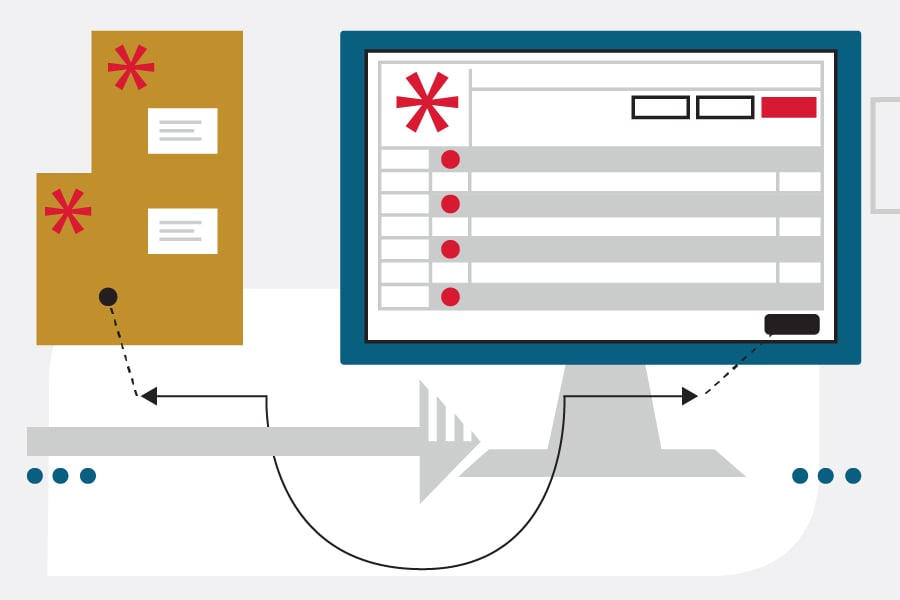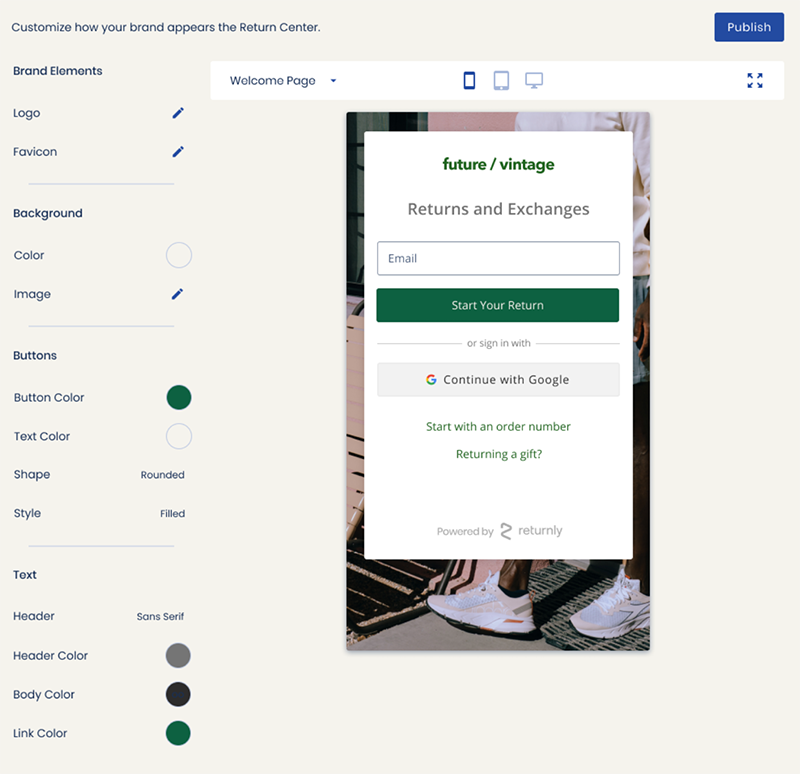Logistics
Industries
Technology & Innovations
E-commerce
E-commerce Fulfillment Services
Lease & Maintenance
Semi Trucks
Logistics
E-commerce
Lease & Maintenance
Buy Used Trucks

It’s easy for merchants to view friction in the returns process as a good thing. After all, why would you want to encourage customers to make more returns?
But high returns aren’t necessarily the enemy of profitability. Just because a customer is choosing to return an item, this doesn’t mean they want to terminate their relationship with you.
In fact, studies on return behavior show that the customers who return items most frequently are some of the most profitable to your business.
Why? Because these customers have confidence in your brand’s ability to deliver a smooth return process. While they might end up returning a portion of each order, they bring in more revenue than customers who return less but shop far less frequently.
By implementing a return portal on your website, you can streamline your returns workflow and eliminate friction from the returns process.
We’re teaming up with our integration partner Returnly to explore the power of branded returns portals - and how you can use these capabilities to create the ultimate customer-centric returns experience.
A return portal is an automated return solution where the customer initiates a return using an online system. The portal will normally be hosted on the retailer’s website in a clearly marked location, such as the footer or main navigation menu.
The return portal is where the online returns process takes place for the customer. Nearly all returns management systems, including Returnly, involve the use of a portal to kickstart the returns process. The purpose is to take pressure off your support team by enabling customers to handle to returns process without assistance.
When a customer enters a return portal, they’ll be asked to share their order number or email to retrieve their order from the merchant’s system. The customer then selects which items they would like to return (if permitted by the merchant’s return policy).
If the merchant offers free return shipping, the portal will also generate a return shipping label for the customer. Depending on how sophisticated return software is, customers will be also presented with other options.
For example, some return portals will ask customers to provide the reason why they’re making a return. If a customer selects ‘wrong size/color’ as the reason for returning, a pop-up may prompt them to exchange their item, rather than return it. Capabilities like these make it possible for merchants to shape customer behavior during the returns process and retain more revenue.
Being able to complete a return without needing assistance is the mark of a true customer-centered returns experience. According to Bizreport, 73% of consumers say that they want the ability to solve product or service problems on their own.
Self-service returns are when a customer is able to complete the returns workflow without needing prior authorization from a customer service representative. Making it easier for customers to reach their desired outcome e.g. a refund or exchange, results in much more satisfying returns experiences. In fact, 92% of consumers say they will buy from a merchant again if the return process is easy.
By using advanced automation, return portals can enforce the merchant’s chosen return policy without needing input from your customer care team. This frees up time for personnel to focus on more complex issues, while also removing friction from the returns process for customers.
If a returned item isn’t damaged or defective, this means that it wasn’t a good fit for the customer’s needs. But that need hasn’t simply disappeared; nearly two-thirds of consumers plan on exchanging or finding a replacement for an item they’ve returned.
A high exchange rate demonstrates two things: That you have high levels of customer loyalty and an effective returns workflow that encourages online shoppers to consider alternatives to refunds. But without the latter, it’s extremely difficult to persuade even your most loyal customers to pursue exchanges.
For example, if a customer’s return needs to be received into the warehouse before they can get their replacement item, they’ll just ask for a refund and place a separate order. Implementing a returns portal that allows for one-click exchanges - including for items of a higher value - enables merchants to incentivize exchanges much more effectively.
The most important question about returns isn’t what customers are returning, or even how often; it’s why.
Knowing what causes customers to ask for a refund is the key to reducing the flow of revenue out the front door of your business - especially when so many reasons for returns can be mitigated.
Return portals allow you to seamlessly gather this data from your customers to understand what changes should be made to the shopping experience. For example, if ‘wrong color’ is a frequent complaint by customers, you may need to revisit the color accuracy of your product photography. In this way, return portals help you to reduce rather than increase your return rates over time.
When you design your online store, you don’t just choose a template and be done with it. You take the time to add unique brand elements that enable customers to build trust and familiarity with your business.
So, why should your return portal be any different?
Because returns occur during the post-purchase phase of the customer journey, the branding opportunities presented by the returns experience are often neglected by retailers.
But if your website directs customers to a generic return portal, this is a big disruption to the customer experience. A lack of branding can create suspicion about entering personal details, which results in more pressure on your care team to field inquiries from confused customers.
A returns process that isn’t a natural extension of the shopping journey creates friction for customers, resulting in negative return experiences that could push them away from your brand.
“Consistent branding across customer touchpoints helps reinforce a merchant’s story, sparking a connection with shoppers and serving as a competitive differentiator.” Says Amy Mokris, head of Partner Marketing at Returnly. “By branding their Return Center, merchants can deliver customized customer-centric support that is consistent with a shopper’s experience pre-purchase.”
An automated, self-service return portal that reflects your brand identity enables merchants to support more customers in less time, all the while driving loyalty, profits, and customer lifetime value.
So, how can you create a return portal that streamlines the return process and reflects your brand story? Fortunately, Returnly is here to help!
While there’s a huge number of returns management systems to choose from, they don’t all offer merchants the same level of customization. Most tools will allow you to upload your logo or change background images. But without broader style changes, it’s difficult to make your return portal truly reflect your brand.

With Returnly, merchants can customize their return portal from end to end with just a few clicks. Intuitive branding controls make it easy for merchants to select buttons, styles, and accent colors that span the full width of the return experience.
One of the biggest benefits of return portals in the era of smartphones is that customers can make returns and exchanges on the go - but only if your design is optimized for different devices.
According to Oberlo, 75% of consumers opt to carry out purchases on their mobile devices - yet 90% say that the mobile ecommerce experience could be improved. If your return portal isn’t catering to this demographic, that’s a lot of customers who could be receiving a lackluster returns experience.
Returnly features a responsive portal design that makes it easier than ever for busy consumers to complete their returns without a hitch. Large light boxes for showcasing products across desktop and mobile enable merchants to drive exchanges more effectively, in turn retaining more revenue.
Branding isn’t just about your visual assets. It’s about the feeling that customers get when navigating your return portal. The way you communicate with your customer using CTAs and prompts will help to recreate your brand’s personality during the return process.
“Merchants can build consumer trust by aligning their return portal with the personality and values that customers experienced pre-purchase.” Says Mokris. “By using your brand voice and tone when communicating returns, you can delight shoppers all while building brand loyalty and affinity with your customer base.”

With Returnly, merchants can customize the text on every page of their return portal, from the login page all the way to confirmation. This ensures that customers feel like they’re interacting with your brand during every step of the return process, creating a consistent brand experience that boosts customer loyalty.
Returns management is a vital but often forgotten part of the ecommerce experience. Without a seamless, intuitive returns workflow, customers are more likely to have negative return experiences that put them off from shopping with your brand in the future.
With returns, exchanges, and refunds now firmly embedded into modern eCommerce, how you manage these experiences determines whether returns will drive revenue - or whether it will cause losses.
In sum, the easier returns are for your customers, the easier it is for you to foster repeat business.
As a Ryder integration partner, Returnly is the perfect option for merchants who are looking for a best-in-class return solution. Returnly enables your business to embrace a brand-centric, automated approach to returns, a massive asset in an increasingly experience-oriented ecommerce sector.